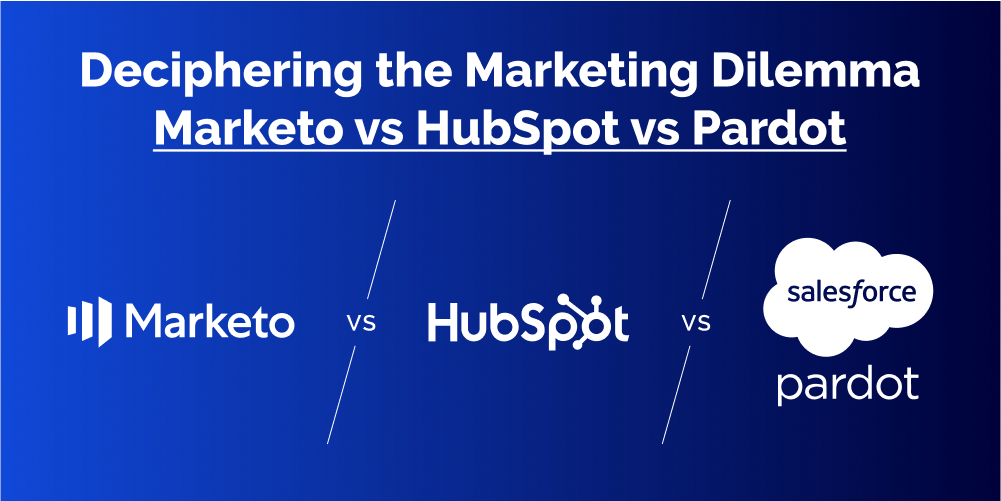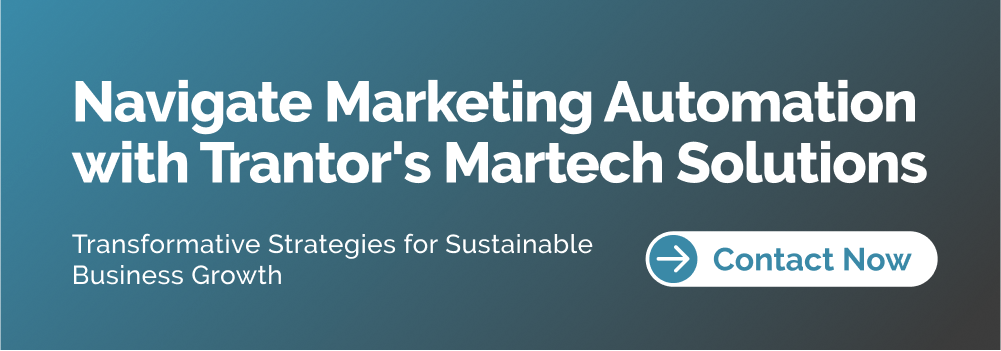Marketing Technology, zBlog
Marketo vs Hubspot vs Pardot: The Marketer’s Dilemma
trantorindia | Updated: December 8, 2023

Introduction
Marketo vs HubSpot vs Pardot? Which one of these is the best? Marketing automation has become an essential component of any modern B2B tech stack. But with over 8,000 martech solutions on the market, simply identifying the right platform can be a challenge. Should you choose an industry leader like Marketo? Opt for an intuitive system like HubSpot? Or leverage a Salesforce native tool such as Pardot?
In this comprehensive guide, we’ll explore the key strengths, limitations, and ideal use cases of three leading marketing automation platforms – Marketo vs HubSpot vs Pardot. You’ll discover how to match software capabilities with your unique business needs across 10 decisive categories. Read on to unlock the keys to selecting your perfect automation solution.
CRM Compatibility

When selecting automation software, cross-platform compatibility is crucial, especially with your central CRM database. Tight CRM integration ensures marketing and sales have a unified view of prospect engagement spanning both systems. Siloed data undermines the entire premise of alignment marketing automation promises.
Marketo touts native compatibility with major CRMs like Salesforce, Microsoft Dynamics, Oracle Sales Cloud and SAP C/4HANA. But its Salesforce integration in particular falls short – sales teams control no Marketo lists or assets. And user-level pairing of CRM salespeople with their Marketo identities remains impossible, muddling cross-channel visibility.
Conversely, HubSpot enables true bi-directional syncing with Salesforce at both lead and user levels. But subtle data naming differences can still scramble integration if setup isn’t meticulous. Also problematic are HubSpot’s list transfer limits to CRMs.
This is where Pardot shines. As a Salesforce platform, it enables frictionless user-and-data-level syncing using connected objects and fields. List transfers flow freely without translation hiccups. For SFDC customers, no tool rivals Pardot’s seamless concordance.
Lead Management Capabilities
Mature lead scoring and grading functionalities are vital for savvy automation platforms. Scoring tracks prospect engagement while grading lets you tier leads based on profile quality. When used together, they unlock superior targeting and personalization.
Marketo provides ample scoring configs but lacks any grading functionality for prioritizing inbound leads. You’re forced to rely solely on scoring models filtered through multiple buyer personas. HubSpot mirrors this weakness despite offering predictive scoring models.
Pardot stands apart here as the sole provider of both robust lead scoring and customizable grading frameworks. You’re empowered to align scoring with interests while grading reflects ideal customer profiles. This powers smarter segmentation, nurturing and routing. Sophisticated Pardot users even feedback grading performance to sales teams to continuously perfect lead quality assessment.
Campaign Orchestration and Attribution

The ability to quickly build targeted campaigns grouping associated marketing assets is automation 101 today. But cleanly attributing pipeline influence across touchpoints remains a struggle for many platforms.
Marketo enables “smart campaigns” designed to automate multi-asset nurturing workflows triggered by cues like form fills. Performance rollups provide some insight but multi-touch attribution remains opaque. HubSpot falls short allowing zero campaign asset re-use – want a landing page in two campaigns? Prepare to clone it.
Pardot’s connected campaigns truly bridge the gap by mirroring associated CRM campaigns for turnkey closed loop reporting. Robust analytics like Marketing Cloud’s B2B Suite track granular ROI across campaigns while Einstein predictive models optimize spends. This end-to-end alignment remains unmatched.
Email Capabilities
Email still conveys marketing’s highest ROI, so rock-solid email builders and connectors are obligatory for automation apps. Between templating functionality and delivery infrastructure, not all solutions are created equal.
Marketo’s updated email editor is more usable but clunky with limited wiggle room for customized styling. HubSpot wins on ease-of-use with its drag-and-drop builder but lean plans throttle daily sends. Neither provide native testing for rendering and spam.
Pardot’s killer offering is its deep template modification flexibility, enabling extensive custom modules without touching code. Plus its ties with Salesforce Marketing Cloud provide access to advanced email analytics. And Pardot uniquely serves integrated email tests for rendering, spam potential and security pre-launch.
Landing Page and Form Creation

Beyond emails, automation platforms must also streamline landing page and form building – two other vital demand gen assets. Ideally with minimal coding skills required.
Marketo offers two page builder options: free-form for coding gurus and templated drag-and-drop for less technical users. HubSpot gets high marks for enabling page mockups with simple drag-and-drop widgets. But both force excessive manual tweaks to achieve true mobile responsiveness. Neither empowers much workflow personalization without development help.
Pardot removes user experience roadblocks by harnessing the power of templates. Your design team builds fully customizable modules upfront as dynamic building blocks. Then marketers mix-and-match elements like LEGOs to quickly spawn tailored landing pages linking to configurable forms. And Pardot handles all optimization seamlessly without a developer ever touching the platform.
Webinar and Event Integration
From conferences to tradeshows to virtual summits, events represent pivotal high-touch selling opportunities. Despite happening offline, their marketing impact remains substantial. Automated integrations with widely used webinar and event platforms is now crucial.
Both Marketo and Pardot enable specialized triggers for event registration funnels along with designated post-event nurturing campaigns. But Marketo really excels with its event platform extension “Certain” which bakes in advanced management capabilities like badges, check-in and session tracking.
For its part, HubSpot remains oddly event-agnostic natively, forcing users to leverage apps on its marketplace for popular platforms. The capabilities gap here is puzzling given the channel’s significance. With its Eventbrite and WebEx connectors though, Pardot still covers the basics for most B2B event marketers.
Reporting and Analytics

Generating insights to guide strategy requires digestible analytics – arguably one of the core value propositions of marketing automation itself. The dimensions and depth of reporting vary widely however across solutions.
Users knock Marketo for its dated design and dense metrics lacking intuitiveness. HubSpot earns high marks for visual clarity but subscription tiers dictate viewable analytics depth. For instance, basic plans permit only one campaign attribution model.
Pardot unlocks unparalleled analysis mainly thanks to B2B Marketing Analytics – an add-on reporting engine aggregating campaign data from both Salesforce and Pardot. Marketers access this high-fidelity funnels and revenue tracing without IT help. No competitor delivers this 360-degree perspective natively.
Ease of Use
Even with ample training resources, platform intricacies can throttle user adoption, especially amongst less digitally savvy employees. Complex interfaces resemble airplane cockpits. Modern automation UX should instead emulate smartphones – intuitive enough for toddlers to navigate.
Marketo’s disjointed interface remains notorious for confusing users with countless clicks required to activate basic functions. HubSpot conversely seems designed for tech novices with consumer-grade UX guiding users seamlessly from prospect capture to nurturing campaigns.
When it comes to HubSpot vs Salesforce, Pardot also emphasized usability in its latest “Lightning” release which slots the app natively into Salesforce for familiar navigation. But the legacy UI requires considerable training for navigating endless features. HubSpot still reigns for onboarding speed alone.
Deployment and Support

Selecting any enterprise-level software solution represents a major budgetary commitment amplified by contractual periods and migration costs. This magnifies reliance on vendor support networks and qualified local implementation consultants should challenges arise.
All three platforms maintain communities pooling tribal knowledge across fellow users. For escalations, Marketo and HubSpot both offer premium add-on support plans as needed. Pardot users tap into Salesforce’s expansive expert ecosystem including Trailhead’s renowned training courses.
But exploring key regional partners in advance remains prudent. Will you need guidance creating custom fields and formulas? Email template builders for personalization? Help integrating a webinar platform? Seek out experts early in these domains – projects anchored solely by vendor documentation often drift off course.
The Verdict: Matching Platforms to Specific Needs
So when presented with this marketing automation choice set – how to decide? There exist no inherently “right” or “wrong” options among Marketo, HubSpot and Pardot. The optimal selection depends entirely on your unique priorities.
For B2B enterprises committed to the Salesforce ecosystem who crave frictionless user experiences, Pardot simply can’t be beat. The same holds for complex organizations needing granular campaign analytics or highly customizable nurturing workflows and assets.
Conversely, lean teams prioritizing speed above all should consider adopting HubSpot thanks to its consumer-inspired UX. The intuitive option also makes sense for social media-centric companies given its unparalleled social media marketing campaign integration.
As for Marketo, its greatest asset remains martech maturity accumulated over nearly 15 years perfecting automation. For some, its tools may simply feel the most “proven”. But Marketo shines brightest for B2B firms focused heavily on virtual events management. Its purpose-built event platform remains a hidden gem.
Ultimately no platform ticks every box or suits every business. Making automation work boils down to honest capability assessments – then picking priorities. Of course no choice precludes integrating complementary point solutions later to plug gaps. With this guiding mindset, your ideal automation partner soon reveals itself.
Key Takeaways: Choosing Your Marketing Automation Platform

- Tight CRM and user integration ensures unified data centralization – test thoroughly first
- Mature lead scoring and grading enable smarter segmentation and routing
- Multi-touch campaign attribution remains mission-critical but challenging to perfect
- Email builder flexibility and testing saves resources down the road
- Prioritize platforms with versatile landing page personalization sans coding
- Look beyond software to vendor support ecosystems and regional service partners
- Focus on aligning top platform strengths to your immediate marketing needs
- No solution provides the “perfect” automation answer for every unique business situation
With research and reflection, confidently moving forward in your marketing automation selection gets far less ambiguous. Define your must-have capabilities, nice-to-have features, and calculate your expected return on investment. With this crystal clarity in hand as your north star, navigating the dizzying software landscape suddenly seems far less daunting.
The automation platform market will only continue expanding exponentially in coming years. But by focusing on your specific needs first, identifying the right solution to fuel your marketing engine doesn’t have to be a paralyzing choice. Streamline your decision-making process early on and you’ll find yourself accelerating ahead of competitors.
Conclusion
In the realm of marketing automation, choosing between Marketo vs HubSpot vs Pardot involves weighing unique strengths against specific needs. This guide has dissected crucial categories to empower marketers with informed decisions.
Trantor emerges as your strategic partner as you navigate CRM compatibility, lead management, campaign orchestration, email capabilities, landing page creation, webinar integration, reporting, ease of use, deployment, and support. With expertise in cutting-edge technologies, Trantor aligns solutions with your marketing goals.
In a rapidly expanding market, Trantor stands poised to accelerate your marketing engine. Embrace the future of marketing automation confidently, be it Hubspot or Pardot or Marketo Automation, Trantor is ready to guide you through this transformative journey.




